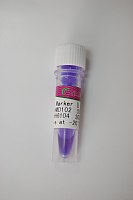Preparation of Gold Nanoparticle–DNA Conjugates
互联网
- Abstract
- Table of Contents
- Materials
- Figures
- Literature Cited
Abstract
This unit describes the preparation of conjugates between nanometer?scale gold particles and synthetic oligonucleotides. Oligonucleotide?functionalized gold nanoparticles are finding increased use in both the construction of complex, tailored nanostructures and the optimization of DNA sequence analysis. The protocols in this unit outline the synthesis, purification, and characterization of nanoparticle?DNA conjugates for applications in nanotechnology and biotechnology. Separate procedures are presented for nanoparticles functionalized with just one or a few oligonucleotide strands and for nanoparticles functionalized with a dense layer of oligonucleotide strands. The different physical and chemical properties of these two types of conjugates are discussed, as are their stability and utility in different environments.
Table of Contents
- Strategic Planning
- Basic Protocol 1: Preparation of Gold Nanoparticle–DNA Conjugates Containing One to Several DNA Strands Per Particle
- Basic Protocol 2: Preparation of Gold Nanoparticle–DNA Conjugates Containing Many DNA Strands Per Particle
- Support Protocol 1: Synthesis of Aqueous Citrate‐Protected Gold Colloid
- Commentary
- Figures
- Tables
Materials
Basic Protocol 1: Preparation of Gold Nanoparticle–DNA Conjugates Containing One to Several DNA Strands Per Particle
Materials
Basic Protocol 2: Preparation of Gold Nanoparticle–DNA Conjugates Containing Many DNA Strands Per Particle
Materials
Support Protocol 1: Synthesis of Aqueous Citrate‐Protected Gold Colloid
Materials
|
Figures
-
Figure 12.2.1 Schematic results for horizontal gel electrophoresis of oligonucleotide‐nanoparticle conjugates. The first, third, and fifth wells were loaded with unmodified gold nanoparticle standards, and the second and fourth wells with the nanoparticle/conjugate mixture (see , step ). The numbers to the right of the gel indicate the number of attached oligonucleotides. The unmodified particles migrate at the zero mark. Each band of successively decreasing mobility corresponds to a nanoparticle with an additional oligonucleotide covalently attached. View Image -
Figure 12.2.2 Assembly of gold nanoparticle conjugates, functionalized with oligonucleotide sequences a and b, onto complementary oligonucleotide templates a′b′. (A ) Nanoparticle conjugates bearing only one oligonucleotide strand assemble selectively into dimers in the presence of the template. More complex structures can be generated from templates with additional recognition segments. (B ) Nanoparticle conjugates bearing many oligonucleotide strands assemble into polymeric macrostructures in the presence of the complementary template. The optical changes associated with this polymeric assembly make this system particularly effective as a colorimetric DNA hybridization sensor. View Image -
Figure 12.2.3 Scheme for conjugation of gold nanoparticles with disulfide‐modified oligonucleotides. An organic mercaptoalcohol is also incorporated into the conjugate. View Image
Videos
Literature Cited
| Literature Cited | |
| Alivisatos, A.P., Johnsson, K.P., Peng, X., Wilson, T.E., Loweth, C.J., Bruchez, M.P. Jr., , and Schultz, P.G. 1996. Organization of ‘nanocrystal molecules’ using DNA. Nature 382:609‐611. | |
| Breslauer, K.J., Frank, R., Bloecker, H., and Marky, L.A. 1986. Predicting DNA duplex stability from the base sequence. Proc. Natl. Acad. Sci. U.S.A. 83:3746‐3750. | |
| Brown, K.R., Walter, D.G., and Natan, M.J. 2000. Seeding of colloidal Au nanoparticle solutions. 2. Improved control of particle size and shape. Chem. Mater. 12:306‐313. | |
| Demers, L.M., Mirkin, C.A., Mucic, R.C., Reynolds, R.A.III., Letsinger, R.L., Elghanian, R., and Viswanadham, G. 2000. A fluorescence‐based method for determining the surface coverage and hybridization efficiency of thiol‐capped oligonucleotides bound to gold thin films and nanoparticles. Anal. Chem. 72:5535‐5541. | |
| Elghanian, R., Storhoff, J.J., Mucic, R.C., Letsinger, R.L., and Mirkin, C.A. 1997. Selective colorimetric detection of polynucleotides based on the distance‐dependent optical properties of gold nanoparticles. Science 277:1078‐1081. | |
| Frens, G. 1973. Controlled nucleation for the regulation of the particle size in monodisperse gold suspensions. Nature Phys. Sci. 241:20‐22. | |
| Gersten, J. and Nitzan, A. 1981. Spectroscopic properties of molecules interacting with small dielectric particles. J. Chem. Phys. 75:1139‐1152. | |
| Grabar, K.C., Freeman, R.G., Hommer, M.B., and Natan, M.J. 1995. Preparation and characterization of Au colloid monolayers. Anal. Chem. 67:735‐743. | |
| Jana, N.R., Gearheart, L., and Murphy, C.J. 2001. Seeding growth for size control of 5‐40 nm diameter gold nanoparticles. Langmuir 17:6782‐6786. | |
| Levicky, R., Herne, T.M., Tarlov, M.J., and Satija, S.K. 1998. Using self‐assembly to control the structure of DNA monolayers on gold: A neutron reflectivity study. J. Am. Chem. Soc. 120:9787‐9792. | |
| Loweth, C.J., Caldwell, W.B., Peng, X., Alivisatos, A.P., and Schultz, P.G. 1999. DNA‐based assembly of gold nanocrystals. Angew. Chem. Int. Ed. Engl. 38:1808‐1812. | |
| Mirkin, C.A., Letsinger, R.L., Mucic, R.C., and Storhoff, J.J. 1996. A DNA‐based method for rationally assembling nanoparticles into macroscopic materials. Nature 382:607‐609. | |
| Storhoff, J.J., Elghanian, R., Mucic, R.C., Mirkin, C.A., and Letsinger, R.L. 1998. One‐pot colorimetric differentiation of polynucleotides with single base imperfections using gold nanoparticle probes. J. Am. Chem. Soc. 120:1959‐1964. | |
| Sugimoto, N., Nakano, S., Yoneyama, M., and Honda, K. 1996. Improved thermodynamic parameters and helix initiation factor to predict stability of DNA duplexes. Nucl. Acids Res. 24:4501‐4505. | |
| Taton, T.A., Mirkin, C.A., and Letsinger, R.L. 2000. Scanometric DNA detection with nanoparticle probes. Science 289:1757‐1760. | |
| Taton, T.A., Lu, G., and Mirkin, C.A. 2001. Two‐color labeling of oligonucleotide arrays via size‐selective scattering of nanoparticle probes. J. Am. Chem. Soc. 123:5164‐5165. | |
| Yguerabide, J. and Yguerabide, E.E. 1998. Light‐scattering submicroscopic particles as highly fluorescent analogs and their use as tracer labels in clinical and biological applications. Anal.Biochem. 262:137‐156. | |
| Zanchet, D., Micheel, C.M., Parak, W.J., Gerion, D., and Alivisatos, A.P. 2001. Electrophoretic isolation of discrete Au nanocrystal/DNA conjugates. Nano Lett. 1:32‐35. | |
| Internet Resources | |
| www.basic.nwu.edu/biotools/oligocalc.html | |
| Provides an extinction coefficient calculator for oligonucleotides. |






